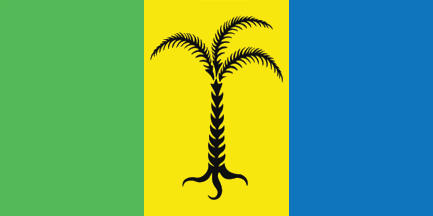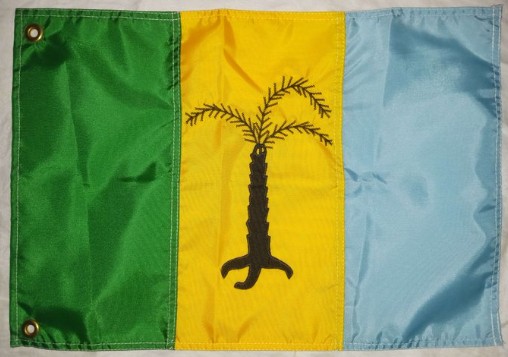 image by Hemendra Bhola, 22 June 2020
image by Hemendra Bhola, 22 June 2020
Last modified: 2025-12-06 by rob raeside
Keywords: st. christopher nevis anguilla | saint kitts and nevis | saint christopher | nevis | anguilla | caribbean | palm tree | lion | crown | governor |
Links: FOTW homepage |
search |
disclaimer and copyright |
write us |
mirrors
 image by Hemendra Bhola, 22 June 2020
image by Hemendra Bhola, 22 June 2020
In 1967 the “triple palm” flag was introduced. Smith 1982
[smi82] shows undefaced
red ensign as ![]() , the palm flag as
, the palm flag as ![]() .
.
Željko Heimer, 01 January 2003
 image located by BlinxCat, 27 November 2025
image located by BlinxCat, 27 November 2025
This variant of the flag has noticeably less detail on the main tree, the
roots of it appear to have their root tips removed and shrunken and the shade of
blue is lighter. The flag is also shorter.
BlinxCat, 27 November 2025
The vertical tricolour with the palm tree
was adopted on 27 February 1967 when
St. Christopher (=St. Kitts) - Nevis - Anguilla
became an Associate State. The palm tree had
three branches, standing for the three islands.
On 12 July the same year Anguilla
seceded and declared its independence in 1969.
Mark Sensen, 26 October 1995
Why these three Caribbean flag, all from of 1967, are so similar?
Anticipating that St Vincent would become an Associated State the
College of Arms designed a new flag; green over yellow over blue with a
central badge of berries and leaves. They seem to have been trying to
create a family of flags for islands of the former
West Indian Federation.
David Prothero, 04 Aug 1999
Flagwise, history starts with Leeward Islands
flags (blue ensign, governor). These were used until, what? 1958?
Then there was West Indies with the blue wavy
flag 1958-1962.
Željko Heimer, 01 Jan 2003
Here are details culled from the Encyclopædia Britannica: All three
islands were discovered by Columbus in 1493. He named the
principal island San Cristóbal after his patron
saint. The nearby island (3 km away) of Nevis
takes its name from "las nieves" (="the snows"), a reference to
Columbus’s observation of the cloud cap on the island peak.
San Cristóbal was officially named Saint Christopher by the
English (note: this was an English colony —
the English were very possessive about their colonies, even after the union of
the English and Scottish crowns), but the colonists who went to live there in
1623 almost immediately called it St Kitts. Both names were used.
A French settlement was also established on St Kitts in 1827. The
Treaty of Utrecht handed the island in its entirety to Britain in 1713. The
French invaded the island again in 1782, capturing Brimstone Hill, but were
expelled. Anguilla was named by the French because of its resemblance
to an eel ("anguille") — it is 25 km long, and nowhere wider
than 5 km. It became an English colony in 1650.
Reference to an atlas tells me that Anguilla lies some distance to the
north of St Kitts and Nevis, being separated by St Barthélemy and St
Martin/Sint Maarten, and is the northernmost island of any size to the east
of the Anegada Passage (Sombrero islet lies to the north, however).The three islands were joined in a single colony in 1882, but the name
Anguilla was initially not used in the colony’s name. It was called
either St Christopher and Nevis or St Kitts-Nevis.
The name St Christopher, Nevis and Anguilla (or St Kitts-Nevis and
Anguilla) was first used on postage stamps only in the late 1940s, when
the portrait of the grey-haired King George VI was introduced in place of the
previous younger portrait.
Mike Oettle, 05 Jan 2003
I found once a copy of Life dated March 17, 1967, which has an article about
the "new" Caribbean states that were just gaining statehood (and will gain full
independence another 15 years later).
I tore out page 37 and 38 (the magazine was headed for the garbage anyways)
because of the vex-aspect of a few pictures.
Page 37 has a VERY interesting photo - I wish my scanner was working so I could
scan and show it. (If there's interest, I'll hold on to it until I can get it
scanned) - the caption is
"NEW FLAG. St. Kitts new flag is strung on a barbed-wire fence (left, above)
alongside the British colors that first flew over the
island in 1623."
Now, before you get a mental picture in your head, the picture shown is quite
misleading. There are indeed two Kittisians stringing up two flags on a barbed
wire fence, but the left flag is a horizontal tricolour of the then-national
colours, basically a carbon-copy of Gabon, but a lighter
field of blue. To confuse matters more, there is what seems to be a cheap 1 by 2
foot national flag (vertical tricolour of g-y-b) sticking out of a fencepost in
the picture, but there doesn't seem to be a tree on the middle stripe (although
the middle stripe isn't that clear, as the flag is bent at that stripe). The
biggest surprise of all, the "British colors" referred to
in the caption are what looks to be a Dutch flag! (I've
studied the picture over and over and can't see a British connection to that at
all - the flag isn't completely shown, the picture cuts off, but 2/3 of it at
least is shown, and that 2/3 is the Dutch flag!) They are
the British colours in the sense that they use
red-white-blue on their flag, but, what the Dutch flag is
even doing there is beyond my comprehension ...
David Kendall, 11 October 2005